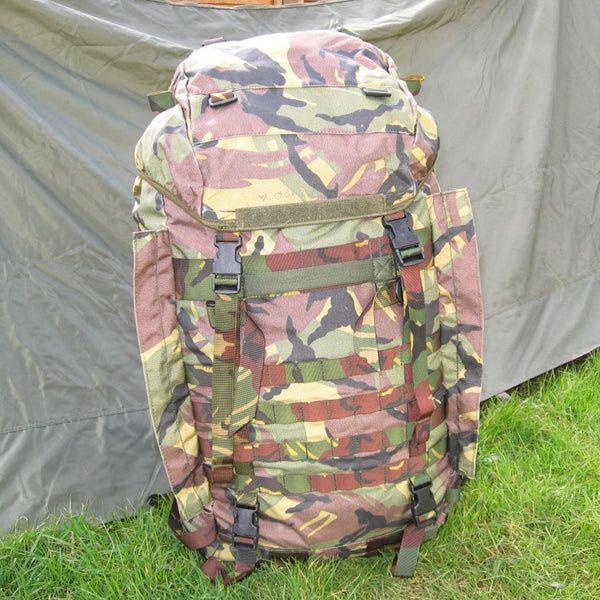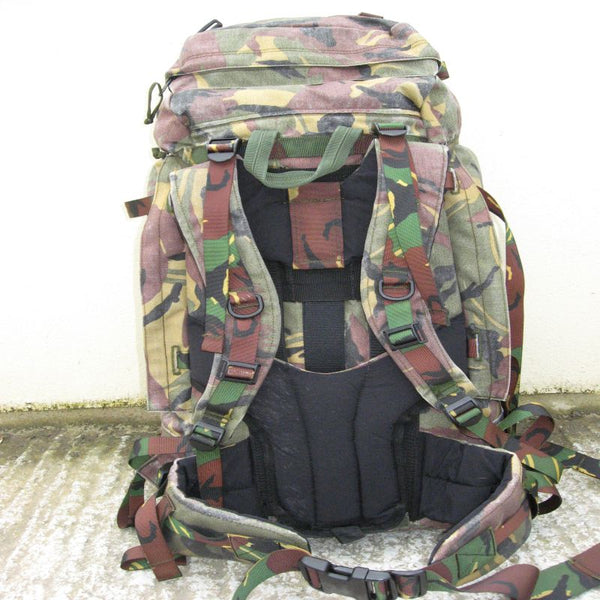The Dutch army Sting has a volume of 60 litres plus 2x 10 litres in the detachable side pouches.
Into the side pouch fits very well a German army mess kit and a US army canteen on top of it with still a bit room aside, let's say for a sitting pad.
I don't own the British Osprey field bottle though and can't compare the height but the width should be OK. Otherwise one could easily attach two MTP coloured British army bottle carriers to the belly of the rucksack because the PALS field there is compatible with the MOLLE straps of the MTP Osprey pouches. I guess you can additional attach there in one line two of the MTP utility pouches, that are just a bit smaller than the water bottle carrier but have under the flap an additional draw string closure as it's known as snow collar from the main compartments of most modern rucksacks.
You can't get the Dutch bottles factory new so I will stick with the British pouches although they have a different camouflage pattern.
I own all that but bought the Dutch army Sting just recently because I looked for one in good condition. Around Christmas I can try how the pouches really fit onto the rucksack, but so far I see now it should work very well.
The Dutch mess kit fits with a bit spare room into the British bottle carrier, MTP.
I think the British mess kit is a bit higher, no idea if it still fits. I guess that we have members who can tell you that.
Under the detachable side pouches of the Sting you find a couple of loops on the sides of the rucksack that are oriented in both directions, vertically and horizontally. I think you can attach fishing rods here very well and afterwards reattach the side pouch and at the bottom of the side of the rucksack there is an open pocket at each side with a draining hole. The pockets are a bit larger than the rear pockets on usual jeans, so you could put here the end of the fishing rod.
The Sting has one main compartment without the usual weak point, the zipper for the sleeping bag compartment is missing, it's just one sack.
Under the lid is a flat zippered pocket, on top of the lid is another well accessible pocket with more volume. And inside at the back is a flat but relatively large water bladder pocket with velcro closure.
The Sting is approximately constructed like the Karrimor SF Sabre 45 but a bit larger. The main difference are the PALS / MOLLE straps at the belly and more important is that the Sting has different to the Karrimor SF Sabre 45 a very well adjustable back length. So, if you are of average height, both are an option for you. But if you are rather tall or rather small, the Sting is the better idea.
Sting version 1 with down closing zippers at the side pouches has no compression straps at the sides of the main compartment, current Berghaus side pouches that look like will fit perfectly. I tried it out.
Sting version 2 has compression straps at the sides and the zippers close upwards like the British issued side pouches in the same colour if we talk about DPM and they fit here.
Otherwise you would mount the side pouches upside down.
Without any doubt it's the best to buy the Sting already with side pouches.
Olive Stings are very rare. Black ones are rather rare but you can find them in Dutch shops. The Sting in DPM is easy to find. The youngest Sting rucksacks are made in NFP, the new Dutch camouflage pattern. One can get them too, a bit more expensive.
I payed approximately 70 € for a used but nearly new looking Sting DPM rucksack last weak and got it in Hildesheim in Germanys oldest Military surplus shop Räer (Raeer). Dutch Milsurp shops offer them often a bit more expensive but tell you more about the conditions they offer and offer all colours apart from plain olive green.
The Arwy versions are made in Belgium, the Lowe Alpine versions are Asian I think but seem to be very good as well. The construction was created by Lowe Alpine, Arwy continues to make them exclusively for the Dutch army in license.
They are more robust than most current civil models but otherwise not insanely over built or heavy.
That's a rucksack that you can try out without regrets because you could sell it for the same price you payed.
From that point one could think about Savotta Jääkari L, KarrimorSF Sabres, Berghaus Atlas or Crusader or whatever, which are very similar, but larger or smaller and slightly different. But the Sting has a good allround size and well thought out construction, it's out developed and army approved and for the low price absolutely no fault.
All similar options are usually much more expensive and I am quite unsure if you will notice the differences in real use, apart from the size of course.
The KarrimorSF Sabre 45 isn't much smaller, but the Berghaus Atlas and Crusader and Dutch army (Lowe Alpine / Arwy) Sarracen are much bigger than the Sting.
The 110 to 120 litres are nice to have for winter camping but for a short hiking tour in the warmer month you start to get packing problems with a 110 litres Atlas because they are much larger than needed. One can manage that but it isn't optimal. And different to the Atlas the Crusader has no compression straps at the sides, what's not so good in my opinion if we talk about such a big rucksack. Crusaders and Atlas rucksacks can be bought used from the Dutch and German army, the slightly smaller Vulcan as British army surplus. Or you can get all of them factory new. But the prices of the used ones are so high that I decided to get a factory new Atlas. You have to pay attention and compare the prices!
And yes. I first bought the Atlas factory new and find it great. But afterwards I bought a used Sting. Simply because I don't need 110 litres volume all the year round. Would I have to choose just one I would take the Atlas of course, but around Berlin we can get pretty cold weather and I travel with the stuff all year round. By railway train.
110 litres of equipment and still easily portable is high state of the art. If you don't pay attention you suddenly have 30 kg in there. That's not so funny.


